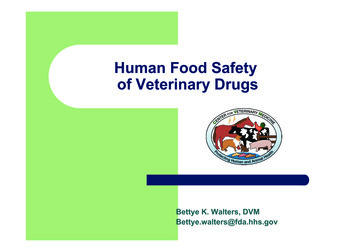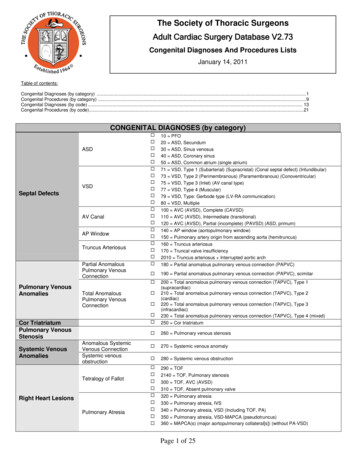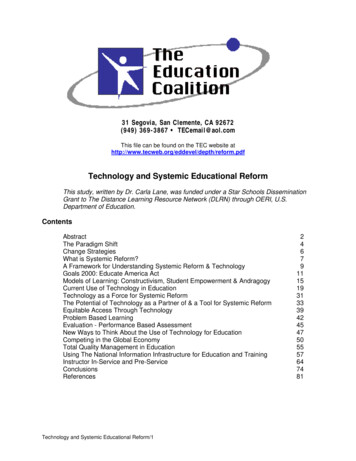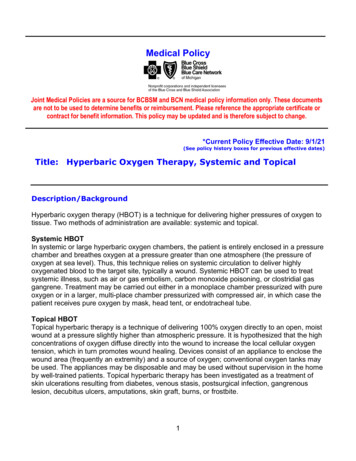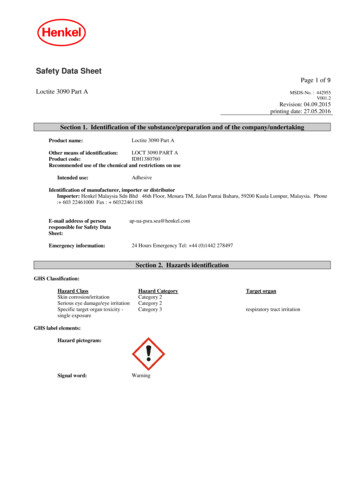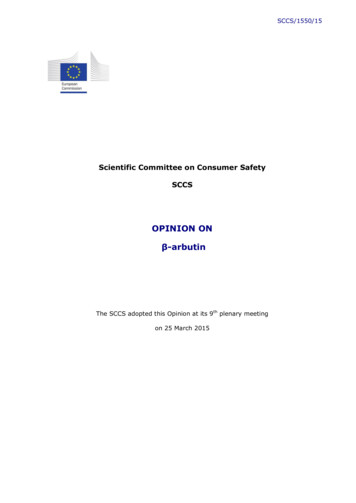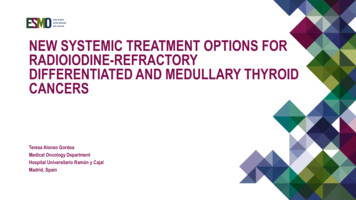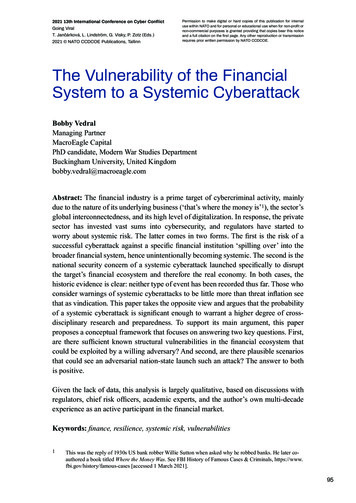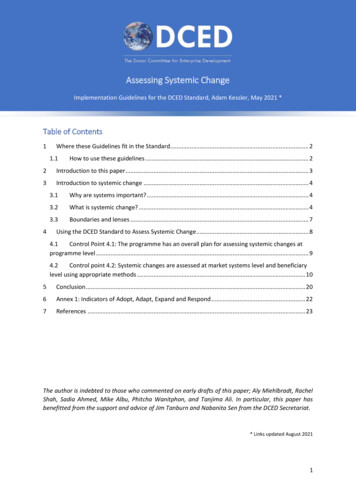
Transcription
Critical Reviews in Toxicology, 36:37–68, 2006c Taylor and Francis Group, LLCCopyright ISSN: 1040-8444 print / 1547-6898 onlineDOI: 10.1080/10408440500534370A Tiered Approach to Systemic Toxicity Testingfor Agricultural Chemical Safety AssessmentJohn E. DoeSyngenta CTL, Macclesfield, United KingdomAlan R. BoobisImperial College London, United KingdomAnn BlackerBayer CropScience, Research Triangle Park, North Carolina, USAVicki DellarcoU.S. Environmental Protection Agency, Office of Pesticide Programs, Washington, DC, USANancy G. DoerrerILSI Health and Environmental Sciences Institute, Washington, DC, USAClaire FranklinHealth Canada, Pest Management Regulatory Agency, Ottawa, Ontario, CanadaJay I. GoodmanMichigan State University, East Lansing, Michigan, USAJoel M. KronenbergMonsanto Company, St. Louis, Missouri, USARichard LewisSyngenta CTL, Macclesfield, United KingdomErnest E. McConnellTox Path, Inc., Raleigh, North Carolina, USAThierry MercierINRA-GMPV-RD, Versailles, FranceAngelo MorettoUniversità di Padova, Padova, ItalyCanice NolanDelegation of the European Commission, Washington, DC, USAStephanie PadillaU.S. Environmental Protection Agency, National Health and Environmental Effects Research Laboratory,Research Triangle Park, North Carolina, USAThe views expressed in this article are those of the authors and do not necessarily reflect the views or policies of the U.S. EnvironmentalProtection Agency, the European Commission, or other institutions represented by the authors.Claire Franklin is currently with The McLaughlin Centre for Population Health Risk Assessment, University of Ottawa, Ontario, Canada.Lorraine Tilbury is currently with Pfizer Global Research & Development, Amboise, France.Address correspondence to Nancy G. Doerrer, ILSI Health and Environmental Sciences Institute, One Thomas Circle, NW, Ninth Floor,Washington, DC 20005, USA. E-mail: ndoerrer@hesiglobal.org37
38J. E. DOE ET AL.Whang PhangU.S. Environmental Protection Agency, Office of Pesticide Programs, Washington, DC, USARoland SoleckiFederal Institute for Risk Assessment, Berlin, GermanyLorraine TilburyDupont de Nemours Ag Products, Nambsheim, FranceBennard van RavenzwaayBASF Aktiengesellschaft, Ludwigshafen, GermanyDouglas C. WolfU.S. Environmental Protection Agency, National Health and Environmental Effects Research Laboratory,Research Triangle Park, North Carolina, USAA proposal has been developed by the Agricultural Chemical Safety Assessment (ACSA) Technical Committee of the ILSI Health and Environmental Sciences Institute (HESI) for an improvedapproach to assessing the safety of crop protection chemicals. The goal is to ensure that studiesare scientifically appropriate and necessary without being redundant, and that tests emphasizetoxicological endpoints and exposure durations that are relevant for risk assessment. The ACSASystemic Toxicity Task Force proposes an approach to systemic toxicity testing as one part of theoverall assessment of a compound’s potential to cause adverse effects on health. The approach isdesigned to provide more relevant data for deriving reference doses for shorter time periods ofhuman exposure, and includes fewer studies for deriving longer term reference doses—that is,neither a 12-month dog study nor a mouse carcinogenicity study is recommended. All availabledata, including toxicokinetics and metabolism data and life stages information, are taken intoaccount. The proposed tiered testing approach has the potential to provide new risk assessmentinformation for shorter human exposure durations while reducing the number of animals usedand without compromising the sensitivity of the determination of longer term reference doses.KeywordsAgricultural Chemicals, Health-Based Guidance Values, Risk Assessment, SABREDatabase, Systemic Toxicity Testing, Tiered TestingINTRODUCTIONThe ILSI Health and Environmental Sciences Institute(HESI) formed the Agricultural Chemical Safety Assessment(ACSA) Technical Committee in the year 2000 to design a toxicity testing scheme that would incorporate current understandingof pesticide toxicology and exposure and recognize the specificity of agricultural products. The purpose of and backgroundfor the ACSA project are described in detail in the companionpaper by Carmichael et al. (2006).As the proposed tiered testing approach for agricultural chemical safety assessment evolved, the ACSA Technical Committee and its task forces (Barton et al., 2006; Carmichaelet al., 2006; Cooper et al., 2006) worked toward the followingobjectives: Provide information that can be applied to a range ofrelevant human exposure situations. Characterize effects that have the potential to damage human health at exposure levels approximatingthose that might be encountered in the use of thesecompounds. Avoid high doses that cause unnecessary public concern (e.g., safety assessments should focus on dosesthat are relevant to realistic human exposures whilemaintaining adequate power for the experimental studies to detect toxicity).Use the minimum number of animals necessary to produce a thorough safety assessment of the chemicals ofinterest.Inflict the minimum amount of distress on animals.Minimize excessive and unnecessary use of resourcesby regulatory authorities and industry which could beused to address other issues of concern.Increase both the efficiency and relevance of the currentsafety assessment process.Definition of the Scope of Systemic ToxicityThe goal of the Systemic Toxicity Task Force (the Task Force)of the ACSA Technical Committee was to develop a hierarchy ofstudy types, endpoints, and triggers for a decision tree for other
A TIERED APPROACH TO SYSTEMIC TOXICITY TESTINGtoxicity endpoints, such as neurotoxicity, carcinogenicity, andchronic toxicity. The Task Force defined “systemic toxicity” forthe purposes of the HESI project as the potential adverse effectsof agricultural chemicals on “young adults.” In this context, systemic toxicity includes general toxicology and specific effectson the nervous system, the immune system, and the endocrinesystem; genetic toxicology; carcinogenicity; and irritancy andsensitization.The assessment of systemic toxicity in “young adults” is oftenthe first step in the overall assessment of a compound’s potential to cause adverse effects on health. The findings in youngadults are then taken into account during the assessment of thecompound during different life stages, including reproduction,development, adolescence, and the elderly. The process for assessing the effects of agricultural chemicals on these life stagesis the subject of the companion paper by the ACSA Life StagesTask Force (Cooper et al., 2006). A complete assessment canbe made only by taking into account all of the data generatedin the overall assessment. Modes of action may be revealed inthe assessment of systemic toxicity that will also reveal themselves in the assessment of different life stages. The assessmentsare underpinned by knowledge of toxicokinetics, from whichinternal, rather than externally applied, dose can be related toeffects. The ACSA ADME Task Force has reviewed the assessment of toxicokinetics data (Barton et al., 2006). The work ofall three ACSA Task Forces is complementary and should beconsidered together. A key aspect of the overall approach described here is to provide data that shed light on the shape ofthe dose-response curve, rather than emphasizing effects thatmay occur only at high doses. Reference doses are usually seton the critical effects, that is, the first effects occurring as thedose level is increased, although such dose levels are usuallydiscovered by reducing the dose level until effects are no longerobserved.ASSESSMENT OF THE CURRENT TESTING STRATEGYComparison of the Agricultural Chemical Testing Strategywith Safety Assessment Strategies for Other ChemicalsThe Task Force reviewed the way in which food additives,biocides, and pharmaceuticals are assessed by regulatory authorities in Europe and the United States. Each includes the conceptthat the studies that are done should reflect the toxicity of thechemical and its use profile.The factors that are taken into account include: Exposure level, frequency, and duration.Level of toxicological concern about the chemical.Each regulatory agency has a declared intention to limit thenumber of animals used in assessing the potential hazards of achemical.The testing schemes for food additives, biocides, and pharmaceuticals differ from the current agricultural chemical testingscheme in that they allow more opportunity for the use pro-39file, the resulting exposure, and the toxicological profile of thechemical to influence the design of the evaluation program.Human Exposure Durations Requiredfor Risk AssessmentsThe range of required risk assessments has increased in recentyears as knowledge has grown concerning the range of exposuresto which humans may be subjected. Initially, the assessment ofagricultural chemicals focused on continuous dietary exposure,which gave rise to the concept of the acceptable daily intake(ADI) for a lifetime. However, it is now recognized that there isa much broader range of exposure durations that must be considered, including exposures of workers applying agriculturalchemicals, exposures of bystanders, home use, and short-termexposures in the diet. The Task Force identified the followinghuman exposure durations for which risk assessments may berequired: One day.Two to 28 days.One to 6 months. Greater than 6 months. The Task Force considered whether there should be further division of the duration of exposure of “greater than 6 months,” bearing in mind that this exposure duration ranges from 7 months ofexposure to a lifetime’s exposure, and that it would, therefore,be equivalent to the traditional lifetime ADI. The Task Forceconcluded that there would be relatively few occasions when areference dose derived for a lifetime would be excessively conservative for 7 months exposure duration. Such situations wouldlikely become apparent as the chemical properties are examinedand the testing program progresses.Exposure can occur from a variety of sources, including exposure to the concentrated compound during manufacture, transport, and dispensing; exposure to more dilute compound duringthe application of the compound; and exposure to residues in dietand drinking water. In addition, intermittent exposure should beconsidered. The Task Force created a data set that could providerisk assessors, who are acting to safeguard the health of thoseusing agricultural chemicals or who may be exposed to them indiet, drinking water, or as bystanders, with information to allowthe assessment of the impact of a wide range of potential humanexposures.Matching Current Studies with Exposure Durationsfor Risk AssessmentsThe current testing strategy employed by regulatory agenciesaround the world is primarily focused on two scenarios: Single exposure to large amounts of the undilutedsubstance. Prolonged exposure to the substance in the diet.
40J. E. DOE ET AL.In addition, there are two areas of concern for regulatory authorities that have received attention in recent years and for whichnew study designs have been or are under development: Medium-term exposure during mixing/loading byoperators. Single-day dietary exposure.The acute toxicity package of oral, dermal, inhalation studies,skin and eye irritation, and skin sensitization is designed to assess the effects of single exposures to the undiluted substance.The acute toxicity studies use death or severe toxicity as anendpoint, and the data are applied primarily for classificationinto various hazard categories for transport and general handlingpurposes.The effect of prolonged exposure in the diet is assessed bythe current program of studies that starts with a 28-day rat study.Note that the 28-day rat study is often viewed as a dose-settingstudy, and is not always submitted to regulatory authorities. Theprogram of studies then proceeds to the 90-day rat study andthe chronic rat study, which usually includes an assessment ofcarcinogenicity. In addition, a parallel series of studies is donein the dog (90-day and 1-year). A mouse carcinogenicity studyis performed. Data are also generated to explore the effect of thechemical on reproduction and development. These studies havebeen considered by the ACSA Life Stages Task Force (Cooperet al., 2006). The data from these studies are used to identifyand characterize the hazards of the substance, that is, what effects it causes and at which dose levels. This information is usedin risk assessments. Over the three decades since this processwas introduced, it has become apparent that it no longer meetsall the needs of risk assessors who are acting to safeguard thehealth of those using agricultural chemicals or who may be exposed to them in diet, drinking water, or as bystanders. Concernsabout the effects of agricultural chemicals have broadened fromsingle, intermittent, and prolonged dietary exposure, to includeinadvertent exposure in drinking water and application of chemicals in and around the home and other buildings. Despite theseconcerns, risk assessors must use the database provided by thecurrent testing strategy and devise ways to extrapolate the datato meet their needs. A core principle of this project is to startwith the needs of risk assessors and design a series of studies tomeet those needs.Focusing on risk assessment as the purpose for toxicologystudies calls into question whether all the studies that are currently conducted are actually needed. The purpose of hazardcharacterization is to identify the likely adverse health effects,and provide a dose that, if not exceeded, would prevent these adverse health effects from occurring. This reference dose (RfD)can then be compared to the actual or projected exposure throughthe process of risk assessment. In most cases, when the databaseis complete using the large number of animals mandated by thetest guidelines, only one study is used to set the RfD for eachrisk assessment. The question then arises: Would it have beenpossible to eliminate the studies which were not used for riskassessment and still protect human health?Through the use of improved, expanded, and better designedstudies, the Task Force proposes that it is possible to limit thenumber of animal studies required while still identifying thepotential human health hazards of a chemical.ANALYSIS OF THE USE OF THE CURRENT DATABASEThe current program for the assessment of agricultural chemicals has been in place for more than the last quarter of the 20thcentury. Although it has evolved somewhat during that time, itscore has remained essentially unchanged. Hundreds of chemicals have been evaluated, which together form a rich database onthe toxicity of agricultural chemicals. The Task Force acknowledges that any changes to the current assessment program mustnecessarily be based on sound scientific data. Consequently, arepresentative cross section of the large data set on the toxicityof agricultural chemicals was selected as a reference point forthe Task Force. This data set was examined to determine whichstudies have been used most often to set the key reference RfDsfor chemicals. The data guided the Task Force in the selectionof study types to be used in the future and the identification ofstudy types that may not be necessary. To achieve this objective,the Task Force commissioned the SABRE (Safety Assessmentby Refined Experimentation) database described next.Description of the SABRE Database and OtherData SourcesInitially, two to six chemicals from each class of pesticide (i.e., organophosphates, carbamates, pyrethroids, etc.) wererandomly selected from a list of chemicals whose toxicologydatabase had been evaluated by the Hazard Identification Assessment Review Committee (HIARC) of the Health EffectsDivision (HED), Office of Pesticide Programs (OPP), U.S. Environmental Protection Agency (EPA). During the U.S. EPAevaluation process, various toxicity endpoints (such as acute andchronic RfDs, incidental oral or dermal endpoints) were selectedfor risk assessment purposes. For each pesticide, the rationale forthe toxicity endpoints and the conclusion of the peer review wererecorded in a HIARC document, which served as a good startingpoint for data mining. The document contained all the necessaryrecord keeping information in the OPP database (i.e., PC codeand MRID number). With the PC code, the appropriate Registration Eligibility Document (RED) or Registration Standardcould be easily accessed. In a RED, a summarized section of thetoxicity for a pesticide is excerpted from the Toxicology Chapterprepared by HED. From the Toxicology Chapter, the individualstudy data evaluation report (DER) could be obtained. Withinthe Toxicology Chapter, a toxicology profile of a pesticide wasalways prepared and included. The toxicology profile of a pesticide contained brief summaries of essentially all the relevanttoxicity studies used to establish toxicity endpoints. Information included date of the study, dose levels tested, no-observedadverse-effect level (NOAEL), lowest-observed-adverse-effect
A TIERED APPROACH TO SYSTEMIC TOXICITY TESTINGlevel (LOAEL), and the effects seen at the LOAEL. The toxicology profile was a crucial source for data mining. For theselected pesticide, another database, Toxicology Onliner, wasalso searched for additional information on older studies, if necessary. Under some circumstances, the HIARC report, Toxicology Chapter, and the toxicology profile did not provide a cleardescription of the effects; the DER of an individual study wasalways consulted.For tumor incidences of carcinogenic pesticides, the CancerPeer Review Document was consulted. For classification andthe mode of pesticidal action for each pesticide, The PesticideBook (Ware, 2000) was consulted.The relevant toxicology information of each selected pesticide was extracted from the toxicology profile, HIARC report,Toxicology Onliner, DER, and The Pesticide Book (Ware, 2000)to be entered into the data spreadsheet. The information consisted of the summarized results of subchronic oral, dermal,and/or inhalation toxicity studies in rats and dogs; chronic toxicity studies in rats and dogs; carcinogenicity studies in rats andmice; developmental toxicity studies in rats and rabbits; multigeneration studies in rats; acute and subchronic neurotoxicitystudies in rats; and any pertinent special studies. The LOAELand NOAEL used to establish acute and chronic RfDs, tumorincidence, any sex difference in response to the chemical, target organ of toxicity, and the mode of toxicity (if demonstrated)were also entered into the database. In addition, the values forthe acute and chronic RfDs were included. Toxicity informationon 65 pesticides was entered into the database.Interrogation of SABRE and Other DatabasesThe SABRE database, which was built specifically to assistthe analyses presented here, allowed a unique series of questionsto be answered. Of the 65 chemicals held in SABRE, 28 possessed appropriate data (from the core types of study required)for the current systemic toxicity testing paradigm for agriculturalchemicals.These core studies are the 90-day studies in the rat and dog,the combined chronic and carcinogenicity study in the rat, the1-year study in the dog, and the carcinogenicity study in themouse.Using this data set, it was possible to address the followingkey questions concerning the study durations and test speciescurrently used: The frequency with which the rat or the dog is used inregulation (specifically in setting the chronic RfD fora chemical). The identity of study types (durations and species) thatare not used or that provide data that can be obtainedfrom studies of a shorter duration or in a differentspecies.In addressing these questions using the SABRE database, adirect comparison may be drawn between the human durationsrelevant to risk assessment and the utility of current studies in41risk assessment. Most importantly, the analyses were used todifferentiate between those study types that should be retainedand developed for future use, and those that should not.The Frequency with which the Rat or the Dog Is Usedin Setting the Chronic RfD for a ChemicalThe purpose of using two species is to increase the probability of detecting an effect that would be potentially adverseto humans. The second species is used to cover the possibilitythat the rat may not be susceptible to an effect of a compoundto which humans are susceptible, or the rat may be significantlyless sensitive than humans to an effect. The use of a secondspecies that is phylogenetically removed from the rat increasesthe likelihood that one or the other of the species will be at leastas sensitive and/or susceptible as humans. In Table 1, data for28 chemicals are summarized. These are the chemicals from theSABRE database for which there is a complete data set from 90day rat, 90-day dog, 24-month rat, and 1-year dog studies. Theoutcome of the key studies is provided, as is a brief description ofthe critical toxicity endpoints and the species used in risk assessment to set the chronic RfD for each chemical. The followingconclusions may be drawn from analysis of the representativeset of chemicals drawn from the sources cited already: For this set of chemicals, 14 out of 28 (50%) are regulated on the outcome of studies in the dog. Twelve(43%) of these chemicals showed increased sensitivityto the chemical—that is, the same effects were seenbut at lower doses than in the rat. Two (7%) showeda different susceptibility to the chemical—that is, thechemical caused different effects in the dog, which alsohad a lower NOAEL than the overall NOAEL in the ratderived from different effects. For one, the NOAELwas very high in both rat and dog, and the rat NOAELwould be adequately protective of the effect seen inthe dog. For the other, the rat was more sensitive thanthe dog (at 90 days), and the rat NOAEL would againbe adequately protective of the effect seen in the dog.These chemicals are identified in Table 1 by havingeither “sens” (sensitivity, same effect, lower dose) or“susc” (susceptibility, different effect) in the final column if the dog is the species setting the chronic RfD.The Identity of Study Types Not Used in Risk AssessmentStudies in the Rat and the Dog. In comparing the outcome ofstudies of different duration in the rat, the relationship betweenthe respective NOAELs can be variable. However, the NOAELfrom the 90-day study is generally higher than the NOAEL inthe 2-year study for the same toxicity endpoint, indicating that,for this species, the NOAEL can decrease with increasing periodof exposure. For the dog, the quantitative outcomes in 90-dayand 1-year studies are closer. Table 2 summarizes the data forchemicals for which dog NOAELs were lower in longer studies(that is, the one-year NOAEL is lower by a greater than twofold
ilinopyrimidineOrganophosphorothioatePhosphinic acidAnalogue of glutamic buconazoleChemical 590-Day 04—3.1(LOAEL)55211-Yeardog NOAEL(mg/kg/day)0.02(LOAEL)246145610190-Day -Year ratNOAEL(mg/kg/day)Species settingchronic RfDRat: kidney, hematological, thyroid, testesDog (sens)Dog: kidney, liverDog (sens)Rat: kidney, liver at LOAEL (nasaladenomas, high dose)Dog: testes, kidney, clinical chemistry (notumors)RatRat: spleen, bone marrow, and foodconsumption effects; mammary tumorsDog: liver, heartDog (sens)Rat: neoplastic liver nodules, reduced bodyweight gainDog: liver weight, thyroid weight, andreduced body weightDog (sens)Rat: thyroid, bladder, ChEDog: ChE only; 90-day NOAEL was lowerthan 1-year LOAEL on which U.S. EPAregulated ADIRat: liver in 2-year ratRatDog: no 1-year study; Kidney lesions (rat)vs. body weight (dog) at 90 daysRat: ChEDog (sens)Dog: ChERat: kidneys, mortalityRatDog: mortalityRat: fatty liver, testes, and adrenal; reducedDog (sens)body weightDog: fatty infiltration of liverRat: ChE at LOAEL, liver tumors at topRatdoseDog: LOAEL effects not specifiedRat: body weight, liverDog (sens)Dog: neurological, liverRat: hematology, body weightDog (susc)Dog: kidney(Continued on next page)Findings in study of longest durationTABLE 1Data sets for 28 chemicals for which 90-day rat, 90-day dog, 24-month rat, and 1-year dog studies are available (SABRE data)2,4-DActiveingredient42
idePyrethroidOxathinOrganochlorineDiphenyl 274838131030.790.12No study1.317.50.7910.82.56.14003 2.392502.4 12515Nostudy4.380.05 1251NA (0.5 LOAEL)6.2512.59.71.754 0.18 0.254522.41.275632Rat: kidney tubular cell adenomasDog: hemosiderin deposits, liver weight,and alkaline phosphatase90-Day and 1-year NOAELs very similarRat: eyes, ovaries, lung; Leydig celltumors at top doseDog: adrenals, prostate, and testes90-Day and 1-year NOAELs very similarRat: body weight and food consumptionDog: no effects in 90-day or 1-year studiesdone at lower dose levels than ratRat: ChEIDog: ChEIRat: liver weight, body weight, bloodDog: body weightRat: ocular lesions, thyroid 1000-foldsafety factor from ratDog: body weight only (at LOAEL)Rat: body weightDog: body weightRat: noneDog: liver toxicity; body weightRat: ovarian and thyroid tumorsDog: body weight and food consumptionRat: body weight and food consumptionDog: liver and kidney weightRat: bladder tumorsDog: testicular lesionsRat: liver adrenals and testesDog: bloodRat: tremorsDog: tremorsExtra threefold safety factor appliedRat: body weight, kidney, and deathsDog: no studyRat: liverDog: liverRat: adrenal, thyroid, kidneysDog: adrenal, thyroid, kidneysDog (sens)Dog (sens)RatDog (sens)RatDog (susc)RatRatDog (sens)Dog (sens)RatRatRatRatRatRat
44J. E. DOE ET AL.TABLE 2Chemicals for which dog NOAELs were lower in longer exposure studies (SABRE data)Active leLactofen2,4-DBIprodionePropachlor90-Day dogNOAEL(mg/kg/day)1-Year dogNOAEL(mg/kg/day)Species used insetting the ADIRatio dog 90-day:12-month NOAELsRatio rat 90-day:24-month NOAELs104557375860382522.90.79 0.30.632051230difference, excluding the three chemicals for which no NOAELwas determined in the 90-day study). The data show that for the27 chemicals for which there were both 90-day and 1-year dogstudies, in only 8 cases were the 1-year values lower. In three ofthese cases, the chemicals were regulated on the outcome in therat as the most sensitive species, making data generated in thedog redundant for the purpose of setting the chronic RfD.A further analysis of the remaining five chemicals showinglower 1-year dog NOAELs has been undertaken to study the potential influence of dose selection on the outcome of the studies.Table 3 shows LOAELs from the respective 90-day and 1-yearstudies for these chemicals: For hexaconazole, the difference in outcome iswithin threefold and confirmed by both NOAELs andLOAELs. Two 1-year studies have been conducted for acetochlorthat give differing outcomes, with one of the studieswithin twofold of the outcome of the 90-day study. The lower 1-year NOAELs for tebuconazole andlactofen cannot be ascribed to dose selection artifacts.The capability to produce lower NOAELs in studies of longerduration could be a property of the chemical. Rat 90-day andTABLE 3Impact of dose selection on dog LOAELs in 90-day and 1-yearstudies (SABRE data)Active leLactofen90-Day dogLOAEL(mg/kg/day)1-Year dogLOAEL(mg/kg/day)60 452535225012/4020104.4424-month data were compared to determine if this reductionin NOAEL with increasing duration was also seen in the rat(Table 2). Five of the eight chemicals have a similar ratio ofNOAELs between the longer and shorter term studies for bothspecies. For hexaconazole, the NOAELs for all four studies arewithin a range of 2–5 mg/kg (rat 90-day: 3 mg/kg; rat 24-month:4.7 mg/kg; dog 90-day: 5 mg/kg; and dog 12-month: 2 mg/kg),which suggests that the variations may be caused by dose setting. For tebuconazole, the dog 90-day NOAEL is considerablyhigher than the other three NOAELs (rat 90-day: 9 mg/kg; rat24-month: 5 mg/kg; dog 90-day: 73 mg/kg; and dog 12-month:2.9 mg/kg). Butylate is difficult to understand, with the dog 12month NOAEL being considerably lower than the other threeNOAELs (rat 90-day: 32 mg/kg; rat 24-month: 100 mg/kg; dog90-day: 45 mg/kg; and dog 12-month: 5 mg/kg), although theLOAEL is 20 mg/kg.Further analyses of the use of the dog and the optimum studyduration are described in this paper (see Refinement of the Proposal: Role of the Second Species).Studies of Carcinogenicity in the Mouse. In the data set(shown in Table 5), there was one chemical for which 2-year ratand mouse carcinogenicity studies were not available (chlorfenapyr), and there were four chemicals for which there was nomouse carcinogenicity study. The chemicals were classified asshown in Table 4, and they are identified as shown in Table 5.Tumors were detected in the rat, with 13 of the 27 chemicalsremaining in the analysis (6 of these also induced tumors in themouse). An additional four chemicals induced mouse tumors inthe absence of findings in the rat; however, all but one of thesechemicals resulted in liver tumors. The modes
Monsanto Company, St. Louis, Missouri, USA Richard Lewis Syngenta CTL, Macclesfield, United Kingdom Ernest E. McConnell ToxPath, Inc., Raleigh, North Carolina, USA Thierry Mercier INRA-GMPV-RD, Versailles, France Angelo Moretto Universitad iPadova, Padova, Italy Canice Nolan Delegation of the European Commission, Washington, DC, USA Stephanie .
